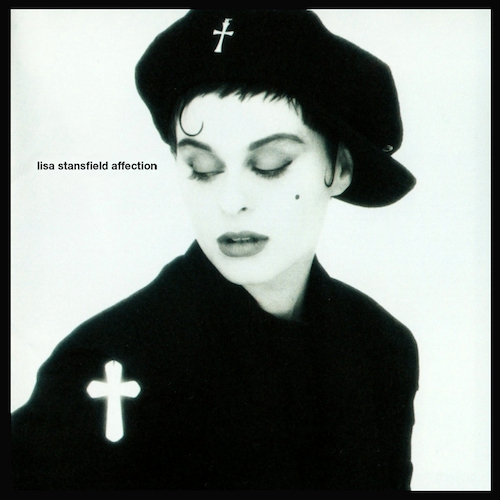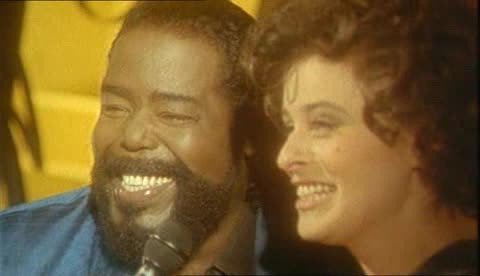 In mid-October 1989, Pop music in America didn’t know which direction it was going in. Take the Top 10 of the BILLBOARD Hot 100 chart for October 14, 1989 for example. You had 80s Pop mainstays Janet Jackson and Madonna leading the pack (“Miss You Much” and “Cherish,” respectively), the future great Grammy taker-awayers, Milli Vanilli (“Girl I’m Gonna Miss You”), a rare big American hit for The Cure (“Love Song”), the last big hit for the Rolling Stones (“Mixed Emotions”), Tears For Fears channeling The Beatles (“Sowing The Seeds Of Love”), rapper Young M.C. with the first (and last) big hit of his own (“Bust A Move”), Hollywood, CA Glam Metal band Warrant (“Heaven”), another big Pop hit for Sweden’s Roxette (“Listen To Your Heart”) and the first Pop single for R&B singer, songwriter and future mega-producer, Babyface (“It’s No Crime”).
In mid-October 1989, Pop music in America didn’t know which direction it was going in. Take the Top 10 of the BILLBOARD Hot 100 chart for October 14, 1989 for example. You had 80s Pop mainstays Janet Jackson and Madonna leading the pack (“Miss You Much” and “Cherish,” respectively), the future great Grammy taker-awayers, Milli Vanilli (“Girl I’m Gonna Miss You”), a rare big American hit for The Cure (“Love Song”), the last big hit for the Rolling Stones (“Mixed Emotions”), Tears For Fears channeling The Beatles (“Sowing The Seeds Of Love”), rapper Young M.C. with the first (and last) big hit of his own (“Bust A Move”), Hollywood, CA Glam Metal band Warrant (“Heaven”), another big Pop hit for Sweden’s Roxette (“Listen To Your Heart”) and the first Pop single for R&B singer, songwriter and future mega-producer, Babyface (“It’s No Crime”).
Meanwhile, over in the U.K., Disco, which saw its peak ten years earlier, was mounting a sort of comeback. Sure, there were Disco influences in the 80s – you heard it in the music of Madonna, Michael Jackson, Lionel Richie, Irene Cara, Queen and Pet Shop Boys, to name a few (Pet Shop Boys even named several of their early remixes as the “Disco Mix”).

In September 1989, Italian Eurohouse band Black Box started a six-week run at No. 1 on the U.K. singles chart with “Ride On Time,” and ended up being the biggest U.K. single of 1989. Black Box would go on to have big global hits in the early 90s, scoring a couple of Top 10 hits in the U.S. with “Everybody Everybody” and “Strike It Up.”

During the last week of Black Box’s reign on the U.K. singles chart, Manchester, England native Lisa Stansfield released – that same week in mid-October 1989 mentioned at the beginning of the blog post – the second single from her then-forthcoming album, AFFECTION – “All Around The World.”
Lisa Stansfield had tried out a solo career back in the early 80s, and released a number of singles, including a 1983 song called “Listen To Your Heart” (no relation to the Roxette song from 1989).

After a brief first try at a solo career, Lisa joined the short-lived trio, Blue Zone, which was a combination of Pop, Dance and Blue-Eyed Soul. Their only album, 1988’s BIG THING, well, wasn’t. It did, however, give Blue Zone (known as Blue Zone UK in the U.S.) one hit on the BILLBOARD Hot 100, with the song “Jackie,” featured in the 1987 film, SUMMER SCHOOL, starring Mark Harmon and Kirstie Alley. “Jackie” reached No. 54 on the Hot 100.

It was not until Lisa’s first collaboration with producer and remixer Coldcut in the Spring of 1989 that gave her a big U.K. hit. The song was “People Hold On,” from Coldcut’s debut album, WHAT’S THAT NOISE?. Lisa sang and co-wrote the song, and it reached No. 11 on the U.K. singles chart and No. 6 on BILLBOARD’s Dance chart. It also had Top 40 success in some countries around the globe.

After “People Hold On” was a hit on both sides of the Atlantic, Arista Records signed Lisa on as a solo artist. Her first successful solo single, “This Is The Right Time,” was released in late July 1989 (it was released as her third single in the U.S. a year later).
“This Is The Right Time” (produced by Coldcut) was a success, reaching No. 13 on the U.K. singles chart, and would go on to fare well in Austria, Canada, Germany, the BILLBOARD Hot 100 (where it reached No. 21), and the BILLBOARD Dance chart, where it spent a week on top in mid-October 1990.
A month before the mid-November 1989 release of Lisa’s debut solo album, AFFECTION, her second U.K. solo single was released – “All Around The World.” And this one WOULD take her all around the world.

Almost immediately, critics and music fans were hooked. ROLLING STONE critic Amy Linden gave the AFFECTION album four out of five stars, saying “the way her voice slinks around the line ‘so-oo sad’ in ‘All Around The World’ show[s] that this is someone who knows her roots even if they aren’t really hers.”
The sound of “All Around The World” was inspired by the late, great R&B legend, Barry White (who would sing, with Lisa, on a version of the song in 1992), and it paid off. Ten years after the peak of Disco, Lisa Stansfield brought the genre back for four-and-a-half minutes and then some all around the world.

The single “All Around The World” was a massive hit nearly everywhere it landed. It spent two weeks at No. 1 in the U.K. in November 1989, and from there, it reached No. 1 in Austria (six weeks), Belgium, Canada (five weeks), Holland (four weeks), Norway, Spain, and two weeks at No. 1 on both of BILLBOARD’s R&B and Dance charts, where it finished 1990 at Nos. 6 and 3, respectively, for the year.
Over here in the U.S., “All Around The World” was released in mid-January 1990, three months after its U.K. release, and the news of its success, well, all around the world was good news to American radio stations and record stores. “All Around The World” debuted on the BILLBOARD Hot 100 just a couple of weeks later, in early February 1990.
A couple of months later, it had reached No. 3, and certainly had the momentum to reach No. 1, but it got stuck in a few tight chart weeks, and it stayed at No. 3 for three weeks. The competition for No. 1 was so tight, in fact, in those three weeks, there were three different No. 1 songs, the last of which was “Nothing Compares 2 U,” the Prince-composed gem of a cover by Sinéad O’Connor.

As it turns out, “All Around The World” really did have the momentum of being a No. 1 song here in America. When BILLBOARD tallied up the top Hot 100 songs of 1990, “All Around The World” beat out the first two songs that did go to No. 1 (and prevented Lisa from going to there), not to mention it beat out several other No. 1 songs that year too.
Though some would prolly classify it more as an R&B or Dance song than a Disco song, I think “All Around The World” had a real big hand in reinvigorating the Disco genre for awhile in the early 1990s, or at least inspiring other artists and / or songs to include that “Disco” influence.
One of THE BEST songs to dance to evah, Deee-Lite’s “Groove Is In The Heart” (released during the Summer of 1990), would certainly fit into that category. Maybe even U2’s “Lemon” (1993), the Pet Shop Boys remix of Blur’s “Girls & Boys” (1994) and the brilliant “Justified & Ancient” by The KLF and Tammy Wynette (1991) would fit into that category as well.

In 1991, Lisa Stansfield was nominated for two Grammy Awards, including Best New Artist and Best Female Pop Vocal Performance, losing out to Mariah Carey in both categories. For the British equivalent of the Grammy Awards, the BRIT Awards, Lisa won Best British Newcomer in 1990 and Best British Female in 1991.
After “All Around The World” (and not counting her vocal contribution to 1989’s “Do They Know It’s Christmas II”), Lisa Stansfield would go on to have 13 more Top 40 U.K. hits, six of those which reached the Top 10. And she did okay over here in the U.S. for awhile. Most recently, she released her seventh solo studio album, appropriately titled, SEVEN, in early 2014. It was her highest-charting U.K. album in 17 years. That same year, she also released her fourth compilation, and her second and third remix albums back-to-back.
Between 1999 and 2013, Lisa Stansfield appeared in five films, and in 1998, she married her second husband – her longtime friend, engineer, mixer, co-writer and co-producer, Ian Devaney. They were married in a small ceremony in New York City.

Hard to imagine at one time I didn’t even like Lisa Stansfield or “All Around The World.” It took me about five years, around my second year living in Portland, but I finally saw and heard what folks were raving about back in 1990. And, once I learned this song was actually a U.K. hit in 1989, you can bet I played this song often on my little 80s radio show, STUCK IN THE 80s. And, why wouldn’t I?
Sure, somewhere in there, “All Around The World” is a melancholy song with some hope (“I can’t find my baby / I don’t know when, I don’t know why / Why he’s gone away / And I don’t know where he can be, my baby / But I’m gonna find him…”). And it did what it set out to do – go all around the world, but also, it helped incorporate and reintroduce a genre that had pretty much been declared dead a decade before, and at a time where Grunge was about to take off, that’s a pretty impressive feat and then some for a song that almost sounds like it could have come out of 1977…
https://www.youtube.com/watch?v=JVuuatjHGnY

